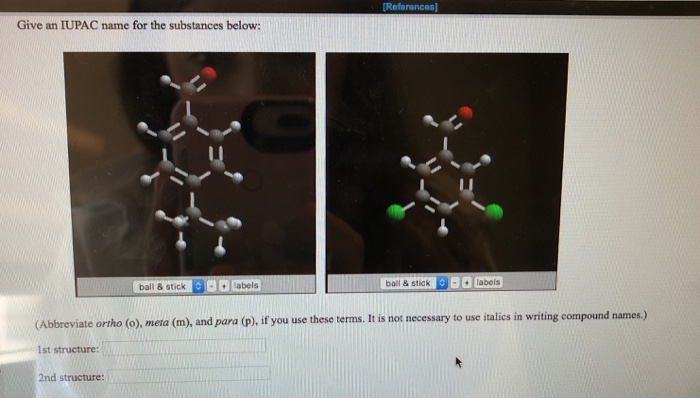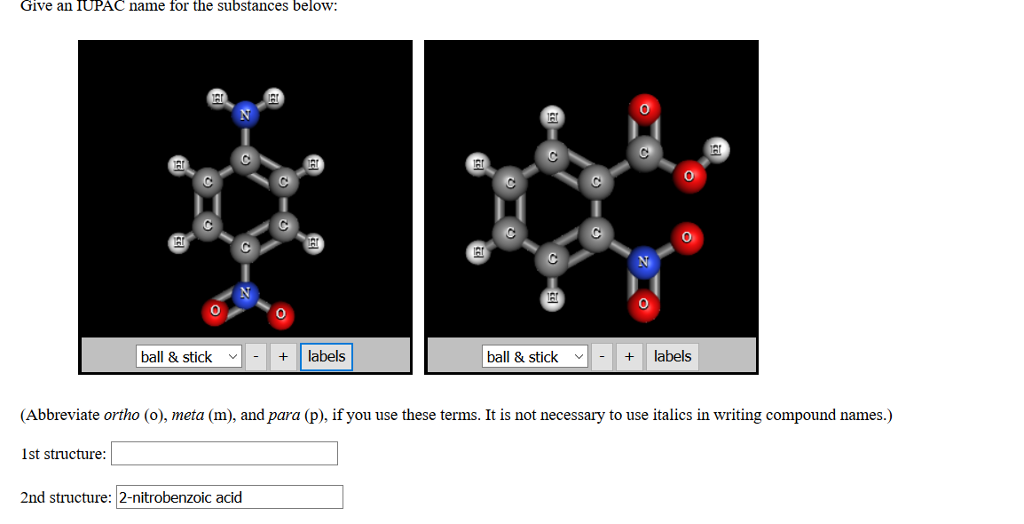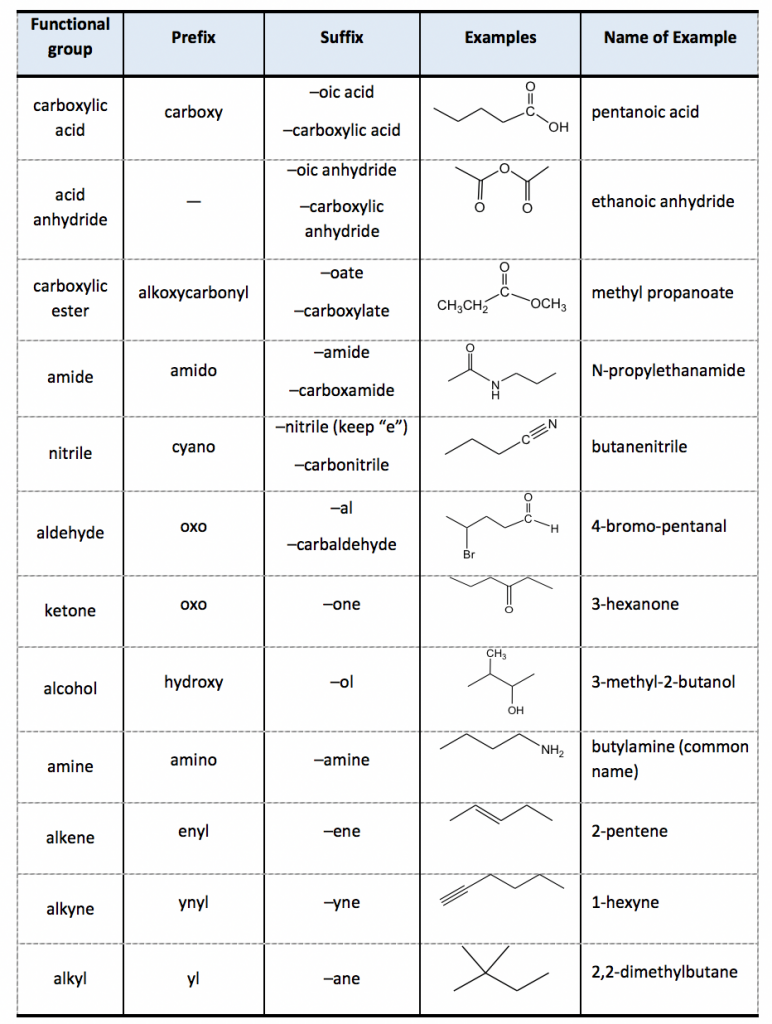Give an IUPAC name for the substances below: ball&sticklabels ball & stick+labels (Abbreviate ortho (o), meta (m), and para (p), if you use these terms. It is not necessary to use italics in writing compound names.) lst structure 2nd structure: p isopropylbenzaldehyde Submit Answer Try Another Version 3 item attempts remaining
Solved Give an IUPAC name for the substances below: | Chegg.com
Mar 28, 2022These rules, used worldwide, are known as the IUPAC System of Nomenclature. (Some of the names we used earlier, such as isobutane, isopentane, and neopentane, do not follow these rules and are called common names .) A stem name (Table 11.6.1 11.6. 1) indicates the number of carbon atoms in the longest continuous chain (LCC).

Source Image: www.pinterest.com
Download Image
The following IUPAC nomenclature rules are helpful in assigning the systematic IUPAC name of an organic compound. 1) The selection of parent chain : The first step in naming an organic compound is to select the parent chain and give the root word based on the number of carbon atoms in it.

Source Image: www.meritnation.com
Download Image
PDF) IUPAC Handout | lacey smith – Academia.edu The IUPAC system of nomenclature is a universally-recognized method for naming organic chemical compounds. The goal of the system is to provide each organic compound with a unique and unambiguous name based on its chemical formula and structure. The name of any organic compound consists of three essential parts: the root word, prefix, and

Source Image: www.chegg.com
Download Image
Give An Iupac Name For The Substances Below
The IUPAC system of nomenclature is a universally-recognized method for naming organic chemical compounds. The goal of the system is to provide each organic compound with a unique and unambiguous name based on its chemical formula and structure. The name of any organic compound consists of three essential parts: the root word, prefix, and Sep 15, 2022Two OH groups on the first and fifth carbon atoms make the compound a diol and give the name 1,5-pentanediol (rule 3). Exercise 14.2.1 14.2. 1. Give the IUPAC name for each compound. Example 14.2.2 14.2. 2. Draw the structure for each compound. 2-hexanol. 3-methyl-2-pentanol.
Solved There are several aromatic compounds with the formula | Chegg.com
3 Naming alkyl halides 5 Naming carbonyl compounds The compound has an \ (-\text OH\) (hydroxyl) functional group and is therefore an alcohol. There are The compound has a carbonyl group and no other functional groups. Therefore it is either an aldehyde or a ketone. The carbonyl group carbon atom Give the IUPAC name for each of the following: Spell out the full name of the compound. | Homework.Study.com

Source Image: homework.study.com
Download Image
Solved Give an IUPAC name for the substances below: | Chegg.com 3 Naming alkyl halides 5 Naming carbonyl compounds The compound has an \ (-\text OH\) (hydroxyl) functional group and is therefore an alcohol. There are The compound has a carbonyl group and no other functional groups. Therefore it is either an aldehyde or a ketone. The carbonyl group carbon atom

Source Image: www.chegg.com
Download Image
Solved Give an IUPAC name for the substances below: | Chegg.com Give an IUPAC name for the substances below: ball&sticklabels ball & stick+labels (Abbreviate ortho (o), meta (m), and para (p), if you use these terms. It is not necessary to use italics in writing compound names.) lst structure 2nd structure: p isopropylbenzaldehyde Submit Answer Try Another Version 3 item attempts remaining

Source Image: www.chegg.com
Download Image
PDF) IUPAC Handout | lacey smith – Academia.edu The following IUPAC nomenclature rules are helpful in assigning the systematic IUPAC name of an organic compound. 1) The selection of parent chain : The first step in naming an organic compound is to select the parent chain and give the root word based on the number of carbon atoms in it.

Source Image: www.academia.edu
Download Image
IUPAC Rules In chemical nomenclature, the IUPAC nomenclature of organic chemistry is a method of naming organic chemical compounds as recommended by the International Union of Pure and Applied Chemistry (IUPAC). It is published in the Nomenclature of Organic Chemistry (informally called the Blue Book).Ideally, every possible organic compound should have a name from which an unambiguous structural formula
Source Image: www.chem.uiuc.edu
Download Image
2.4 IUPAC Naming of Organic Compounds with Functional Groups – Organic Chemistry I The IUPAC system of nomenclature is a universally-recognized method for naming organic chemical compounds. The goal of the system is to provide each organic compound with a unique and unambiguous name based on its chemical formula and structure. The name of any organic compound consists of three essential parts: the root word, prefix, and

Source Image: kpu.pressbooks.pub
Download Image
Nomenclature Examples Sep 15, 2022Two OH groups on the first and fifth carbon atoms make the compound a diol and give the name 1,5-pentanediol (rule 3). Exercise 14.2.1 14.2. 1. Give the IUPAC name for each compound. Example 14.2.2 14.2. 2. Draw the structure for each compound. 2-hexanol. 3-methyl-2-pentanol.

Source Image: www2.chemistry.msu.edu
Download Image
Solved Give an IUPAC name for the substances below: | Chegg.com
Nomenclature Examples Mar 28, 2022These rules, used worldwide, are known as the IUPAC System of Nomenclature. (Some of the names we used earlier, such as isobutane, isopentane, and neopentane, do not follow these rules and are called common names .) A stem name (Table 11.6.1 11.6. 1) indicates the number of carbon atoms in the longest continuous chain (LCC).
PDF) IUPAC Handout | lacey smith – Academia.edu 2.4 IUPAC Naming of Organic Compounds with Functional Groups – Organic Chemistry I In chemical nomenclature, the IUPAC nomenclature of organic chemistry is a method of naming organic chemical compounds as recommended by the International Union of Pure and Applied Chemistry (IUPAC). It is published in the Nomenclature of Organic Chemistry (informally called the Blue Book).Ideally, every possible organic compound should have a name from which an unambiguous structural formula